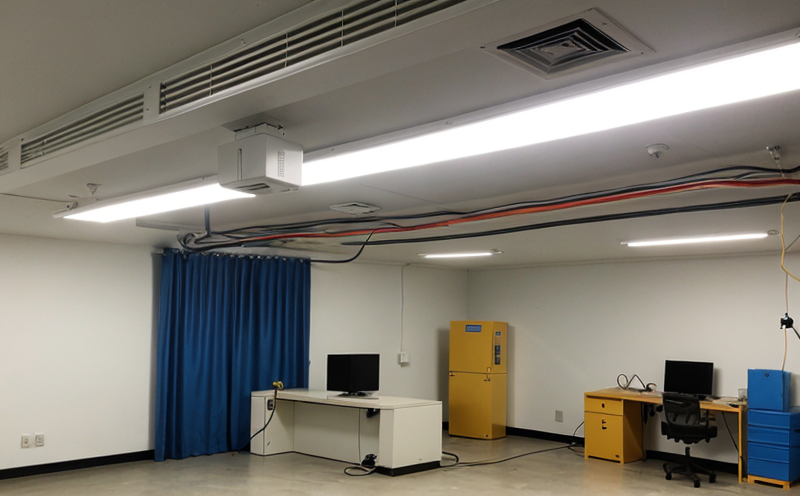IEC 60068-2-2 Environmental Test Procedures
The IEC 60068-2-2 standard specifies environmental test procedures for the determination of the temperature and humidity effects on electrical and electronic equipment. These tests are crucial in ensuring that products perform reliably under a wide range of environmental conditions, which is particularly important in sectors like Building & Infrastructure Testing where materials and components must withstand harsh weather and operational environments.
IEC 60068-2-2 defines specific procedures to simulate the effects of temperature cycling between high and low temperatures. The standard covers a wide range of test conditions, including:
- Cycling between -40°C and +85°C
- Humidity levels up to 93% relative humidity at room temperature (23 ± 2°C)
- Exposure to wet heat conditions
The testing process involves subjecting the specimen to these environmental conditions in a controlled environment. This ensures that any changes or failures can be directly attributed to the environmental factors rather than other variables.
Specimen preparation is critical before conducting IEC 60068-2-2 tests. The specimens must be representative of the products they will ultimately represent. For instance, if testing a lighting system component in a building environment, it would need to be prepared as close to its final form as possible.
The instrumentation used for these tests includes environmental chambers capable of maintaining precise temperature and humidity levels. Modern systems often incorporate advanced sensors and data logging capabilities to ensure accuracy and repeatability. The test results are typically documented with detailed reports that include the conditions under which the testing was conducted, any observed changes in performance or failure modes, and recommendations for further action.
Understanding IEC 60068-2-2 is essential for ensuring compliance with international standards, particularly in sectors where quality and reliability are paramount. By adhering to these tests, manufacturers can ensure that their products meet the necessary environmental robustness requirements before they reach the market.
Why It Matters
The importance of IEC 60068-2-2 testing cannot be overstated. In Building & Infrastructure Testing, where electrical and lighting systems are integral to the functioning of structures like buildings and infrastructure projects, these tests ensure that products can withstand the environmental stresses they will encounter in real-world applications.
Failure to comply with IEC 60068-2-2 standards could lead to premature product failure, leading to costly repairs or replacements. For quality managers and compliance officers, ensuring adherence to these standards is crucial for maintaining a high level of product integrity and reliability.
R&D engineers benefit from understanding the impact of environmental factors on their designs. By incorporating IEC 60068-2-2 testing early in the development process, they can identify potential issues before they become major problems. This proactive approach not only enhances product performance but also reduces time-to-market and costs associated with rework or recalls.
For procurement professionals involved in selecting components for building projects, compliance with these standards is a key factor in ensuring that suppliers deliver products capable of performing reliably under all expected environmental conditions.
Industry Applications
- Bulb Testing: Ensuring the durability and reliability of lighting fixtures, especially those exposed to extreme temperatures or humidity.
- Safety Switches: Verifying that protective devices function correctly under varying environmental conditions.
- Circuit Breakers: Assessing the performance of circuit breakers in harsh environments to prevent system failures and ensure safety.
- LED Lighting: Testing for stability and efficiency under different temperature cycles, ensuring long-term reliability.
The applications are vast, ranging from residential lighting systems to complex industrial installations. The tests help guarantee that the products will function correctly in real-world conditions, thereby enhancing safety and reducing maintenance costs.
Eurolab Advantages
At Eurolab, we pride ourselves on providing comprehensive IEC 60068-2-2 testing services. Our facilities are equipped with state-of-the-art environmental chambers that can simulate a wide range of temperature and humidity conditions. This allows us to provide accurate and reliable test results for our clients.
Our team of experts has extensive experience in conducting these tests, ensuring that we understand the specific requirements of each project. Whether you're developing new products or need to ensure compliance with existing standards, Eurolab can offer tailored solutions.
In addition to testing capabilities, Eurolab also provides comprehensive support services, including consultation on specimen preparation and interpretation of test results. This ensures that our clients are fully informed about the implications of their testing and can make data-driven decisions.
Our commitment to quality is reflected in our adherence to international standards such as IEC 60068-2-2. By choosing Eurolab, you ensure that your products meet the highest levels of environmental robustness requirements.





